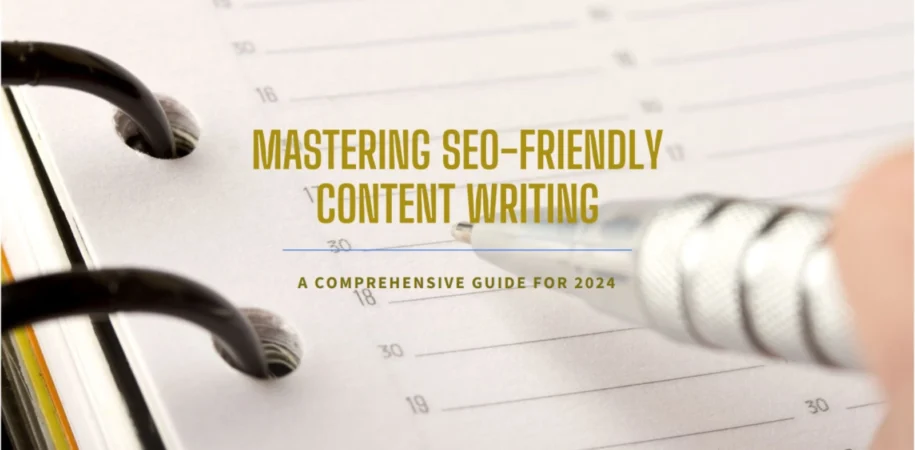In the 2024 AI Era, the digital landscape continues to evolve rapidly. Staying ahead in SEO-friendly content writing is crucial for visibility and engagement. This guide will walk you through the updated best practices and emerging trends in SEO content creation for 2024.
1. Understand the Evolving Search Landscape
Search engines are becoming smarter and more user-centric.
- AI and Machine Learning: Search algorithms increasingly leverage AI to understand user intent.
- Voice and Visual Search: Optimize content for voice assistants and visual search tools.
- User Experience (UX): Google emphasizes Core Web Vitals; ensure your site meets these performance metrics.
2. Deep Dive into User Intent
Understanding user intent is more critical than ever.
- Search Intent Categorization: Informational, Navigational, Transactional, and Commercial Investigation.
- Content Mapping: Align content types with user intent at different stages of the buyer’s journey.
3. Advanced Keyword Research
Keywords remain foundational but require a nuanced approach.
- Long-Tail Keywords: Focus on more specific phrases with lower competition.
- Semantic Search and Entities: Incorporate related concepts and entities to provide context.
- Zero-Click Searches: Optimize for featured snippets and answer boxes.
4. Craft Engaging and High-Quality Content
Quality content is non-negotiable.
- E-A-T Principles: Emphasize Expertise, Authoritativeness, and Trustworthiness.
- Original Research and Data: Provide unique value with proprietary data or case studies.
- Storytelling: Engage readers with narratives that resonate.
5. Optimize for Featured Snippets and Rich Results
Aim to capture prime real estate on SERPs.
- Structured Content: Use bullet points, tables, and numbered lists.
- Answer Questions: Address common queries directly and succinctly.
- Schema Markup: Implement structured data to enhance visibility.
6. Enhance On-Page SEO Elements
Fine-tune technical aspects for better crawlability and indexing.
- Meta Tags Optimization: Keep title tags and meta descriptions compelling and within character limits.
- Header Tags Hierarchy: Use H1-H6 tags properly to structure content.
- URL Structure: Create clean, descriptive URLs including target keywords.
7. Leverage Multimedia Content
Diversify content formats to cater to different preferences.
- Videos and Podcasts: Integrate multimedia to enrich content.
- Infographics: Use visual data representations to simplify complex information.
- Alt Text for Images: Optimize for accessibility and image search.
8. Mobile-First and Responsive Design
With mobile usage at an all-time high, responsiveness is key.
- Mobile-First Indexing: Ensure the mobile version of your site is fully optimized.
- Responsive Content: Design content layouts that adapt seamlessly to different screen sizes.
- Accelerated Mobile Pages (AMP): Consider AMP for faster mobile page loading.
9. Prioritize Page Experience
User experience directly impacts SEO.
- Core Web Vitals: Optimize for loading speed, interactivity, and visual stability.
- Secure Browsing: Implement HTTPS across your site.
- Avoid Intrusive Interstitials: Ensure pop-ups don’t hinder user experience.
10. Build Author Authority
Establish credibility through author profiles.
- Author Bios: Include detailed bios highlighting expertise.
- Linked Content: Link to author’s social profiles and other publications.
- Google’s Knowledge Graph: Aim to get recognized as an authority in your field.
11. Update and Repurpose Existing Content
Keep content fresh and relevant.
- Content Audits: Regularly review and update older content.
- Repurpose High-Performing Content: Turn articles into videos, podcasts, or infographics.
- Historical Optimization: Update content with new data, trends, or insights.
12. Ethical Link Building
Focus on quality over quantity.
- Guest Posting: Contribute to reputable sites in your industry.
- Build Relationships: Network with other professionals for natural backlink opportunities.
- Avoid Link Schemes: Steer clear of buying links or participating in link farms.
13. Optimize for Local SEO (If Applicable)
Cater to local audiences effectively.
- Google Business Profile: Ensure your profile is complete and updated.
- Local Keywords: Incorporate geo-specific keywords.
- Customer Reviews: Encourage and respond to reviews to build trust.
14. Embrace AI-Generated Content Cautiously
Leverage AI tools with discretion.
- Quality Control: Always review and edit AI-generated content.
- Unique Insights: Use AI to augment, not replace, human creativity.
- Avoid Duplication: Ensure AI content is original and not plagiarized.
15. Measure and Analyze Performance
Data-driven strategies lead to better results.
- Analytics Tools: Use Google Analytics 4 for enhanced tracking.
- Key Metrics: Monitor organic traffic, bounce rate, dwell time, and conversion rates.
- A/B Testing: Experiment with different content elements to optimize performance.
Conclusion
In 2024, SEO-friendly content writing is about blending technical optimization with high-quality, user-focused content. By staying abreast of the latest trends and continuously refining your approach, you can achieve better rankings and deeper engagement with your audience.
Share This Article
If you found this guide helpful, please share it with your network or colleagues who might benefit from these insights.
Stay Connected with Ocean Technolab
We’re committed to supporting your journey in the digital world. Follow us on social media to stay updated with the latest tech trends, tutorials, and insights:
- Twitter: @OceanTechnolab
- Facebook: @OceanTechnolab
- Instagram: @OceanTechnolab
- LinkedIn: @OceanTechnolab
Join the conversation, and let’s build the future together!





8 Comments
Yorumlara bakmadan geçmeyin: https://www.beylikduzukorsantaksi.org/ – Beylikdüzü korsan taksi
En pratik ulaşım yolu: Beylikdüzü korsan taksi.
I appreciate you sharing this blog post. Thanks Again. Cool.
Beylikdüzü korsan taksi konforu yaşamak için tıklayın: https://www.beylikduzukorsantaksi.org/
Very well presented. Every quote was awesome and thanks for sharing the content. Keep sharing and keep motivating others.
A relative of mine once used Fidelity to handle their investments, ending up with a mix of over 10 mutual funds and a total expense ratio close to 1%.
For Canadians aiming to build or rebuild their credit, the Refresh Financial Secured Visa continues to stand out as a reliable choice in 2025. This card works on a fully secured deposit model—meaning your credit limit is backed by the funds you place as security. While it doesn’t include cashback or travel rewards, the purpose of this secured credit card is simple: help you create a consistent payment record and strengthen your credit profile.
“Tempting tease longs for ecstasy.” Here — rb.gy/8rrwju?Nuh